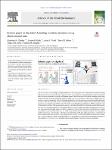Science paper or big data? Assessing invasion dynamics using observational data
| dc.contributor.author | Clubley, Charlotte | |
| dc.contributor.author | Firth, Louise | |
| dc.contributor.author | Wood, LE | |
| dc.contributor.author | Bilton, David | |
| dc.contributor.author | Silva, TAM | |
| dc.contributor.author | Knights, Antony | |
| dc.date.accessioned | 2023-03-20T09:02:46Z | |
| dc.date.available | 2023-03-20T09:02:46Z | |
| dc.date.issued | 2023-03-13 | |
| dc.identifier.issn | 1879-1026 | |
| dc.identifier.issn | 1879-1026 | |
| dc.identifier.other | 162754 | |
| dc.identifier.uri | https://pearl.plymouth.ac.uk/handle/10026.1/20585 | |
| dc.description.abstract |
Non-native species are spreading at an unprecedented rate over large spatial scales, with global environmental change and growth in commerce providing novel opportunities for range expansion. Assessing the pattern and rate of spread is key to the development of strategies for safeguarding against future invasions and efficiently managing existing ones. Such assessments often depend on spatial distribution data from online repositories, which can be spatially biased, imprecise, and lacking in quantity. Here, the influence of disparities between occurrence records from online data repositories and what is known of the invasion history from peer-reviewed published literature on non-native species range expansion was evaluated using 6693 records of the Pacific oyster, Magallana gigas(Thunberg, 1793), spanning 56 years of its invasion in Europe. Two measures of spread were calculated: maximum rate of spread (distance from introduction site over time) and accumulated area (spatial expansion). Results suggest that despite discrepancies between online and peer-reviewed data sources, including a paucity of records from the early invasion history in online repositories, the use of either source does not result in significantly different estimates of spread. Our study significantly improves our understanding of the European distribution of M. gigas and suggests that a combination of short- and long-range dispersal drives range expansions. More widely, our approach provides a framework for comparison of online occurrence records and invasion histories as documented in the peer-reviewed literature, allowing critical evaluation of both data sources and improving our understanding of invasion dynamics significantly. | |
| dc.format.extent | 162754-162754 | |
| dc.format.medium | Print-Electronic | |
| dc.language | en | |
| dc.publisher | Elsevier | |
| dc.subject | Invasion | |
| dc.subject | Spatial spread | |
| dc.subject | Open -source data | |
| dc.subject | Non-native | |
| dc.subject | Range expansion | |
| dc.subject | Magallana gigas | |
| dc.title | Science paper or big data? Assessing invasion dynamics using observational data | |
| dc.type | journal-article | |
| dc.type | Journal Article | |
| plymouth.author-url | https://www.webofscience.com/api/gateway?GWVersion=2&SrcApp=PARTNER_APP&SrcAuth=LinksAMR&KeyUT=WOS:000958712700001&DestLinkType=FullRecord&DestApp=ALL_WOS&UsrCustomerID=11bb513d99f797142bcfeffcc58ea008 | |
| plymouth.volume | 877 | |
| plymouth.publication-status | Published | |
| plymouth.journal | Science of the Total Environment | |
| dc.identifier.doi | 10.1016/j.scitotenv.2023.162754 | |
| plymouth.organisational-group | |Plymouth | |
| plymouth.organisational-group | |Plymouth|Research Groups | |
| plymouth.organisational-group | |Plymouth|Faculty of Science and Engineering | |
| plymouth.organisational-group | |Plymouth|Faculty of Science and Engineering|School of Biological and Marine Sciences | |
| plymouth.organisational-group | |Plymouth|Research Groups|Marine Institute | |
| plymouth.organisational-group | |Plymouth|REF 2021 Researchers by UoA | |
| plymouth.organisational-group | |Plymouth|Users by role | |
| plymouth.organisational-group | |Plymouth|Users by role|Academics | |
| plymouth.organisational-group | |Plymouth|REF 2021 Researchers by UoA|UoA07 Earth Systems and Environmental Sciences | |
| dc.publisher.place | Netherlands | |
| dcterms.dateAccepted | 2023-03-05 | |
| dc.date.updated | 2023-03-20T09:02:41Z | |
| dc.rights.embargodate | 2023-3-21 | |
| dc.identifier.eissn | 1879-1026 | |
| dc.rights.embargoperiod | forever | |
| rioxxterms.versionofrecord | 10.1016/j.scitotenv.2023.162754 |


